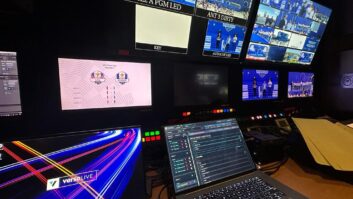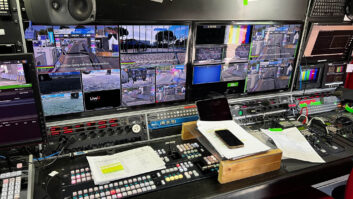During 2022 sports fans will have a whole plethora of action to gorge themselves on. From the Winter Olympics and Paralympics beginning on 4th February, to the Commonwealth Games, and the FIFA World Cup at the end of the year, there’s plenty to keep armchair fans entertained.
But while all this extra sport is on offer, there are still problems for some fans who want to watch their domestic competitions. It’s believed around a third of UK football fans now watch matches via a live stream rather than attend a live match. As more fans choose to watch via OTT than broadcast there becomes more traffic on the internet causing major issues. For example, during a recent Premier League match some fans reported their stream was at least two minutes behind the TV broadcast. With some OTT channels approaching a decade of offering live sport, how can that latency still be acceptable in 2022?
“There will always be an element of delay in streaming video, particularly when watching on a mobile or second screen,” says Chris Wilson, director market development, sports, at MediaKind. “The content must be captured, produced, distributed, encoded, packaged, stored, and then transitioned to content delivery networks (CDNs) for delivery to consumers. Interestingly however, achieving the lowest possible latency is not necessarily the objective for sports streaming services, what’s important is moving as close to broadcast equivalence as possible.”
However, Wilson agrees than anything over 45 seconds is not acceptable to today’s sports audience. “When it comes to professional live video streaming, ensuring that your viewers have a stellar viewing experience is critical to driving adoption of your service and prolonging their engagement – you don’t want them to leave after the first half due to a poor video experience and keeping latency low is imperative to achieving this.
“The ability to reduce glass-to-glass latency from 45-60 seconds to less than 7 seconds – the same level as broadcast-type transmission – is critical to driving the evolution of sports streaming. While there is always a demand for lower latency, <7 seconds assures social media users do not disrupt that content delivered via the streaming path. There’s a slim probability that a live, real-time tweet could be published and processed faster than live streaming data onto your screen.”
For Robert Szabo-Rowe, SVP engineering and product management at The Switch, the goal should not just be achieving latency that is as good as the broadcast feed; the aim should be to get as close to live as possible. “There are delays even in the broadcast chain and broadcasters need to ensure their content is reaching consumers as close to when the action happens on the pitch as possible,” he adds. “It’s now possible for fans to consume OTT content at the venue while the sport is being played, such as for rewinding goals or looking at different angles that they can’t see from the stands.”
So the key thing here is to make sure the OTT feed is as close to a TV operator’s broadcast feed as possible. But how do operators achieve that? “Standard HLS and DASH will give you a streaming latency above 20 seconds and sometimes more than one minute,” explains Alain Pellen, senior market manager OTT and IPTV, Harmonic. “The first step to get closer to broadcast is to use Low Latency (LL) HLS and LL DASH. LL HLS and LL DASH can provide an end-to-end latency in about four to six seconds, which is roughly equal to the typical broadcast latency and may actually be shorter than broadcast in many cases.
“The gap between four and six seconds depends on many factors including the CDN, the type of access network, the bandwidth available on the access network for each user and the player solution. Since the network and CDN conditions are different for each user, you may end up in a situation where some users are streaming video that is aligned with broadcast, while others are streaming video that is ahead by one or two seconds compared with broadcast.”
The solution is to use the DASH target latency parameter in the DASH manifest to indicate to all user devices the target end-to-end latency for the system, states Pelln. “If that parameter is set to match the broadcast latency, then all streaming players will adjust latency to match the DASH target latency, and all users will be aligned on the broadcast latency. A similar mechanism is available with HLS. This is the same mechanism that can be used to ensure all members of a watch together group are viewing the same video with the same latency.”
Latency in the production chain
Low latency technology should also be employed throughout the production chain, says John Carter, director of business development live and sports (EMEA), Grass Valley. “This starts right from the camera — tackling delays on the acquisition side through the support and advancement of JPEG-XS compression is an essential first step to reducing the overall latency. By embedding JPEG-XS compression capabilities directly at the source within broadcast cameras, you can save an encoding stage and reduce connectivity costs while maintaining high image quality. JPEG-XS also offers broadcasters a quicker encode and decode time than traditional JPEG.
“In cloud-focused environments, evolving technologies with innate low-latency and intelligent timing management capabilities are also helping drive innovation and tackle latency challenges for cloud-based live sports productions,” adds Carter.
For Red Bee Media’s head of online development, Anders Wassén, there’s always a trade off between latency and stability. “By optimising standard OTT delivery, we can provide a highly stable end-user experience combined with acceptable latency,” he explains. “For cases where low latency is a requirement, we believe that open standards is the preferred way to optimise even further. The low-latency technology space is crowded by proprietary solutions, but open standard solutions have proven to be very effective and easy to implement.”
Will help will 5G offer?
There’s been much talk about 5G capabilities in terms of production and also delivering content to fans. Could it help reduce the latency issues audiences are currently facing? “5G can help live production professionals easily bring in more remote production elements without adding latency,” says Usman Shakeel, director of solutions architecture for M&E at AWS. “It can also improve general network connectivity/access globally to improve network speeds, buffers, and quality, but won’t have a tremendous impact on latency if segmented HTTP delivery for video is being used. However, the vast majority of latency comes from encoding and buffering, not from the transport method.”
“5G delivery to the end user will help,” adds Harmonic’s Pellen, “in the sense that it is easier to achieve low latency when you are on a stable access network with plenty of bandwidth because then the player doesn’t have to buffer much of the stream before displaying video. Therefore, it is appropriate to say that, on average, 5G delivery will help reduce latency.”
One of the big expectations for sport viewing in 2022 is the rise of live action sports betting. Several major sports leagues in the United States are investigating and partnering with players in the sports book industry to offer ways for fans to place bets on various outcomes during live action while they are watching. But if the stream they’re watching is up two minutes behind broadcast that’s just not going to be feasible. The betting industry has seen double-digit growth globally for several years and is nearly up 40 per cent in some parts of the world like APAC in 2021,” states Xavier Leclercq, VP business development, Broadpeak. “The in-play betting is probably the fastest growing category of betting use-cases today, and clearly consumers betting in these live sports markets demand a level-playing field.
“This means that OTT latency is not only a customer annoyance potentially linked to churn, but a hurdle to increasing revenues for the OTT providers. In-play betting is effectively pushing the OTT industry to reduce latency.”
For sports betting to really take off, it doesn’t only have to be on a par with broadcast – it almost needs to be on a par with the live event itself, adds Alexandre Arnodin, VP of video delivery solutions, Ateme. “Twitter comments can be instantaneous if people are in the venue. Improved low-latency technologies are becoming available for such applications – but relying on proprietary technologies. So, it will take a bit of time for such technologies to be massively available and highly scalable, but industry leaders are definitely working on it, and 5G network capabilities will help to make it happen!”





